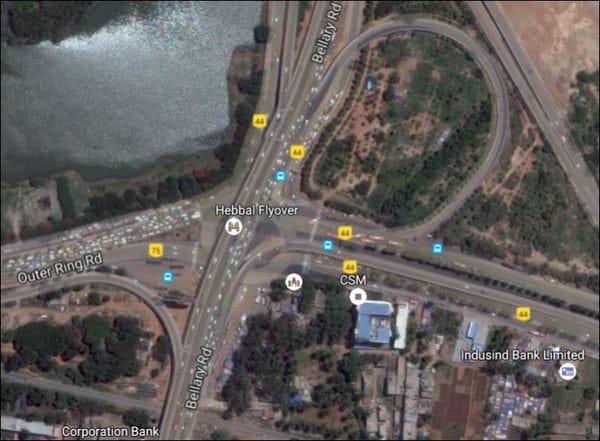Google Earth image of Hebbal traffic choke point.
Why are citizens opposed to #SteelFlyover?
A lot of people have asked during the week, “why are you so opposed to the steel flyover?”
I’ve said to many of them, in reply, that they should pause and think about that question. The answer should be quite easy to spot, especially since so many people have been saying it again and again. They used other words – about governance, and design, and planning, and due process, and a lot of other things that can confuse the issue. But those are the vocabulary of telling you why, not the reason itself.
Why, then?
That’s easy – I love this city. The rest of it is details. At the very core of why I support some things and oppose other things is this very simple reason.
I want the city to be well-planned.
I want it to be inclusive.
I want it to uphold human dignity.
I want it to be a shining example of governance and self-governance.
I want it to be vibrant economically and socially.
I want it to respect its heritage, including the environment it is blessed with.
And as far as I can tell, that’s what it means to love the city.
These things don’t happen by accident. We have to fight for them, repeatedly and strongly. If you start with that, it will be easy to see why the steel flyover doesn’t make any sense.
– By Ashwin Mahesh, Urban expert (Also a Trustee, Oorvani Foundation)
What do citizens want?
“I protest every protest” I wrote so in 2011, during the Anna Hazare led movement.
Tomorrow morning, I will take part in the Human Chain, and demand #beku of the following, instead of the #beda protest.
* A BRT/BPS (Bus Priority System) along the steel flyover alignment – from Hebbal to CBD
* A connected BRT system between Hebbal – Silkboard
* Clear continuous TenderSure-like pavements of over 3m on each side of the road, all along the steel flyover alignment
* Continuous connected pavements on all side-roads within 250m radial distance of the flyover
* Integrate a vehicle-free accessway for pedestrians at Chalukya-BWSSB Circle, similar to the signal-free motorways at these junctions
* Provide plans for pedestrian crossings at Winson Manor, BDA, Cauvery, Mekhri, RT nagar, Sanjay nagar etc.
* Hefty hourly fees for street-side parking in the CBD and arterial roads. Absolutely no free parking on Big10/truck bus route.
Commit to these, and you could go ahead with the chopping of trees and construction of flyover!
Why these demands?
We must invest in public transport alongside every major investment for speeding private vehicle commute. Currently travel time by public transport is over twice of the travel time by car. We cannot skew this ratio further, which projects like the steel flyover will do!
– By Srivatsava Vajapeyam, a software enginerr and a resident of Bengaluru
Related Articles
BDA keeps steel flyover on hold after drawing flak from citizens
Steel flyover debate: Let a plan drive the city transport
BDA botches up the steel flyover issue by hiding information
BDA steel flyover tender documents
Open letter to BBPAG members on steel flyover
BDA steel flyover Detailed Project Report, traffic simulation
